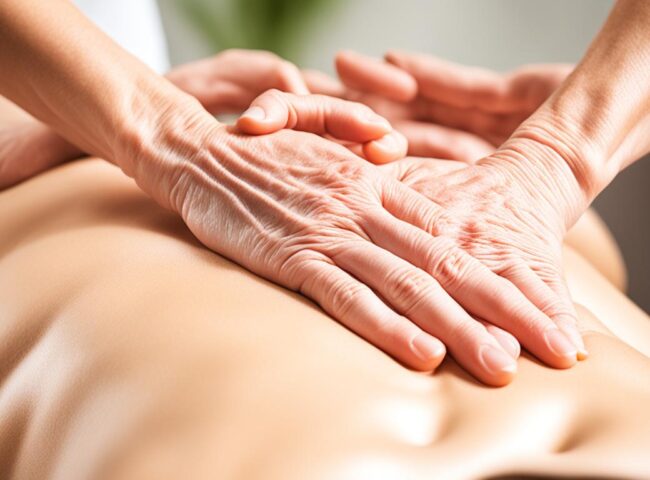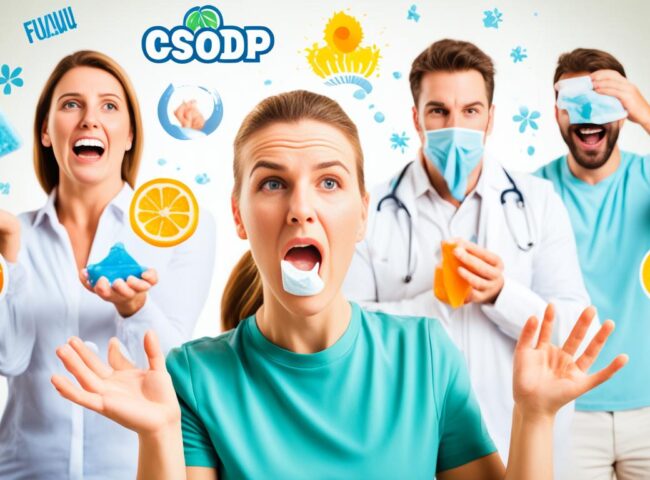PTSD can make life hard, causing intrusive thoughts and anxiety. But, there’s hope. Many effective therapies can help manage PTSD. This article will cover different treatment options, from proven methods to alternative therapies. It aims to give readers the knowledge and support they need to start their recovery journey.
Key Takeaways
- PTSD is a treatable condition with a range of effective therapy options
- Cognitive Behavioral Therapy (CBT) and Exposure Therapy are well-established, evidence-based treatments for PTSD
- Eye Movement Desensitization and Reprocessing (EMDR) is a specialized trauma-focused therapy with proven benefits
- Medication-assisted treatment, mindfulness practices, and complementary therapies can also be valuable components of a comprehensive PTSD treatment plan
- Seeking professional help and overcoming barriers to treatment are crucial steps in the recovery process
Understanding PTSD and Its Impact
Post-Traumatic Stress Disorder (PTSD) is a mental health issue that can come after a traumatic event. It deeply affects an individual’s life, changing their thoughts, feelings, and actions. Knowing about PTSD and its effects is key to helping those who have it.
What is PTSD?
PTSD is a mental disorder that happens to people who have gone through or seen a traumatic event. This can be a natural disaster, a serious accident, a violent attack, or combat. The disorder shows up as reliving the traumatic event, avoiding things that remind you of it, and having negative thoughts and feelings. It also includes being more easily upset and reactive.
Prevalence and Risk Factors
About 3.5% of people in the U.S. have PTSD. Some things make it more likely to get PTSD. These include how bad and long the traumatic event was, if you’ve had trauma before, and your genes. If you’ve had trauma before or were traumatized as a child, you’re more likely to get PTSD.
| Risk Factor | Description |
|---|---|
| Trauma Type | The severity and nature of the traumatic event can influence the risk of PTSD. Events involving interpersonal violence, such as sexual assault or combat, are associated with a higher risk. |
| Personal History | Individuals with a history of previous trauma or mental health conditions are more susceptible to developing PTSD after a subsequent traumatic event. |
| Genetics | Research suggests that certain genetic factors may contribute to an individual’s vulnerability to PTSD, making them more likely to develop the disorder after a traumatic experience. |
Understanding PTSD and its risk factors is key to helping those affected. By spreading awareness, we can support people with PTSD better. This helps them get the care they need to recover.
The Importance of Seeking Professional Help
Dealing with PTSD can feel overwhelming, but getting help is key to healing. Mental health counselors and therapists are crucial. They offer PTSD treatment and support tailored to your needs.
These experts know how to help you manage PTSD. They teach coping skills and help you deal with past traumas. With their help, you can take back control of your life.
Psychological first aid is another important service. It’s about giving support right after a traumatic event. This helps you handle your feelings and sets you up for recovery.
Getting help for PTSD shows strength, not weakness. It means you’re ready to grow and improve. With professional help, you can manage your symptoms and get your life back on track.

You’re not alone in this fight. Mental health professionals offer the care and guidance you need. They help you face PTSD and build a stronger future.
PTSD treatment, trauma therapy, mental health, PTSD symptoms, coping strategies
Dealing with PTSD can feel like a heavy burden, but there are many ways to find hope and healing. PTSD treatment covers both the mind and body, offering a personalized approach for each person.
Trauma therapy is a key part of PTSD treatment. It uses proven methods to help people work through their past traumas. This therapy helps reduce symptoms like flashbacks, feeling overly alert, and avoiding certain places or things. It helps people take back control and feel safe again.
Along with professional help, people with PTSD can try coping strategies to handle their symptoms and boost their mental health. These strategies include:
- Mindfulness and relaxation techniques
- Engaging in regular exercise and physical activity
- Maintaining a healthy sleep routine
- Connecting with supportive social networks
- Practicing self-care activities
By using a mix of professional PTSD treatment, trauma therapy, and personal coping methods, people can get better at recovering. Remember, getting support and knowing what help is out there is key to healing. It’s important for taking back control and finding a fulfilling life.
| PTSD Treatment Approach | Key Benefits |
|---|---|
| Cognitive Behavioral Therapy (CBT) | Helps individuals identify and challenge negative thought patterns, reducing PTSD symptoms |
| Exposure Therapy | Gradually exposes individuals to traumatic memories or triggers in a safe and controlled environment |
| Eye Movement Desensitization and Reprocessing (EMDR) | Utilizes rapid eye movements to help the brain reprocess and integrate traumatic memories |
| Medication-Assisted Treatment | Combines psychotherapy with medication to address both the psychological and physiological aspects of PTSD |
Remember, getting professional help and looking into different PTSD treatment options is crucial for healing. It’s a big step towards living a life full of purpose and joy.

“The greatest weapon against stress is our ability to choose one thought over another.” – William James
Cognitive Behavioral Therapy (CBT)
Cognitive Behavioral Therapy (CBT) is a top choice for treating Post-Traumatic Stress Disorder (PTSD). It’s a therapy that looks at how our thoughts, feelings, and actions are linked. It helps patients take back control and ease PTSD symptoms.
Core Principles of CBT
CBT’s main idea is that our thoughts, feelings, and actions are all connected. By spotting and changing negative thought patterns, people can learn better ways to cope. This helps break the cycle of PTSD symptoms.
Techniques Used in CBT for PTSD
- Exposure Therapy: This method involves facing scary memories or triggers in a safe space. It helps people overcome their fears and lessen the trauma’s emotional impact.
- Cognitive Restructuring: Patients learn to spot and change negative thoughts. They replace these with more realistic and helpful ideas.
- Relaxation Techniques: CBT uses methods like deep breathing, meditation, and progressive muscle relaxation to help manage stress and anxiety.
By using these proven techniques, CBT helps people take back control of their lives. It lessens the effects of traumatic memories and teaches coping skills for PTSD symptoms.

Exposure Therapy
Exposure therapy is a key treatment for post-traumatic stress disorder (PTSD). It helps people face their fears and deal with PTSD symptoms. By slowly exposing patients to what they’ve been avoiding, it helps them take back control of their lives.
This therapy aims to stop avoiding the past that PTSD often leads to. People with PTSD avoid things that remind them of the trauma. This limits their daily life and happiness. Exposure therapy fights this by helping patients face their fears in a safe place.
In exposure therapy, patients talk about their past traumas or face similar situations in a controlled way. This helps their brain process the memories and feelings in a healthier way. Over time, they feel less fear and gain confidence to live their lives fully.
| Benefits of Exposure Therapy for PTSD | Potential Drawbacks |
|---|---|
|
|
Exposure therapy is tough but offers big benefits for those with PTSD. By facing their fears in a safe place, patients can take back control of their lives. They see big improvements in their PTSD symptoms.

“Exposure therapy is not easy, but it is incredibly powerful for helping individuals with PTSD confront their fears and reclaim their lives.”
Eye Movement Desensitization and Reprocessing (EMDR)
EMDR is a therapy that helps people with PTSD and trauma. It’s different from regular talk therapy. EMDR uses fast eye movements or other stimulation to process traumatic memories.
How EMDR Works
In EMDR, a therapist makes the client move their eyes or use other senses like tapping. This helps the brain process traumatic memories safely. It’s like giving the brain a way to make sense of the trauma.
Benefits of EMDR for PTSD
- Reduces the intensity of traumatic memories and associated distress
- Helps clients develop more adaptive and less distressing perspectives on their experiences
- Facilitates the integration of fragmented memories into a cohesive narrative
- Improves overall psychological and emotional well-being
Many studies show EMDR is a top choice for treating PTSD. It targets the deep causes of trauma. This way, people can move past their symptoms and live better lives.

“EMDR therapy has been a game-changer for my clients dealing with PTSD. It’s remarkable to witness the transformation as they’re able to process their traumas and regain a sense of control and empowerment.”
– Dr. Emily Hernandez, Clinical Psychologist
Medication-Assisted Treatment
Medication is a key part of treating PTSD. It helps manage symptoms and ease suffering. Doctors may prescribe antidepressants, anti-anxiety drugs, and other psychiatric medications. These work with therapy to help people with PTSD.
These medications help with symptoms like intrusive thoughts, feeling too on edge, and feeling numb. This makes it easier for people to take part in therapy.
The most common medications for PTSD treatment are:
- Selective Serotonin Reuptake Inhibitors (SSRIs), such as sertraline, paroxetine, and fluoxetine, which can help regulate mood and reduce anxiety
- Serotonin-Norepinephrine Reuptake Inhibitors (SNRIs), like venlafaxine and duloxetine, which can target both depression and anxiety symptoms
- Benzodiazepines, such as clonazepam and alprazolam, which can provide short-term relief for insomnia and hyperarousal
Using medication with psychotherapy, like Cognitive Behavioral Therapy (CBT) or Eye Movement Desensitization and Reprocessing (EMDR), works best. This combo tackles PTSD from both body and mind sides. It makes treatment more thorough and effective.

Choosing to use medication for PTSD treatment should be a team effort. A mental health expert will look at your needs, health history, and overall well-being. They will decide the best treatment plan for you.
Mindfulness and Stress Management Techniques
Dealing with PTSD can feel overwhelming, but adding mindfulness and stress management can change everything. These methods help with PTSD symptoms and build inner peace and resilience.
Benefits of Mindfulness for PTSD
Mindfulness means being fully in the moment. It’s a key tool for managing PTSD symptoms. Studies show that regular meditation can lessen flashbacks, nightmares, and feeling overly alert.
By paying attention to thoughts, feelings, and body signals without judgment, people with PTSD can see their experiences more clearly. This helps them break free from the grip of trauma.
- Improved emotional control and less anxiety
- Better ability to handle and process traumatic memories
- Sharpened focus, concentration, and overall well-being
Stress management techniques like deep breathing, muscle relaxation, and guided imagery are also crucial. They trigger the body’s relaxation response, fighting off trauma’s physical effects. This brings calm and control back into your life.

“Mindfulness is not about trying to get rid of thoughts or feelings; it’s about seeing them as they are, without judgment.”
By using mindfulness and stress management, people with PTSD can take back control. They learn to face their challenges with more ease and strength.
Group Therapy and Peer Support
For those with post-traumatic stress disorder (PTSD), finding a supportive community is key. Group therapy and peer support offer unique benefits that can help with recovery. They work well with traditional PTSD treatments.
Group therapy gives a safe space for PTSD sufferers to share their stories. They learn from each other and develop ways to cope. This way, people understand their condition better, feel less alone, and find comfort in others’ experiences.
- Fostering a sense of community and belonging
- Facilitating the sharing of personal experiences and emotions
- Providing a platform to learn from each other’s coping techniques
- Offering a supportive network for ongoing encouragement and accountability
Peer support groups offer a more casual way to connect with others who understand PTSD. These groups have survivors, advocates, and mental health experts. This mix creates a strong support network.
| Benefits of Group Therapy | Benefits of Peer Support |
|---|---|
| Structured therapeutic sessions led by a professional | Flexible, peer-led gatherings |
| Focused on PTSD-specific treatment and coping strategies | Broader range of topics and experiences shared |
| Opportunity for in-depth exploration and personal growth | Emphasis on mutual understanding and emotional support |
Using group therapy and peer support together can greatly improve well-being and recovery from PTSD. Each approach has its own benefits that can help overall.

“Group therapy and peer support groups can be powerful tools in the PTSD recovery process, providing a sense of community, shared understanding, and ongoing encouragement.”
Complementary and Alternative Therapies
Traditional therapies like cognitive-behavioral therapy and medication help with PTSD. But, research shows that other therapies can also be helpful. Art therapy and animal-assisted therapy are two approaches getting attention.
Art Therapy
Expressive therapy like art therapy lets people express feelings and memories through art. For those with PTSD, it’s a safe way to deal with trauma. By creating art, patients can be creative and express themselves in new ways.
Studies reveal that art therapy can lessen PTSD symptoms like flashbacks and nightmares. It also boosts emotional well-being and helps with self-discovery.
Animal-Assisted Therapy
Animal-assisted therapy is another promising approach for PTSD treatment. It uses trained animals, like dogs or horses, to help with traditional therapies. These animals can make patients feel calmer and more open to therapy.
Research shows that this therapy can reduce anxiety and improve mood in people with PTSD. The bond with the therapy animal brings feelings of safety and trust.
Adding alternative therapies like art and animal-assisted therapy to treatment plans helps people with PTSD. These therapies offer new ways to deal with trauma and improve well-being.

Coping Strategies for Daily Life
Living with PTSD can be tough every day. But, using good coping strategies can really help. We’ll look at how self-care and a strong support system can help you deal with PTSD.
Self-Care Practices
Self-care is key for people with PTSD. It’s important to do things that help your body and mind. This could mean:
- Practicing relaxation techniques, such as deep breathing, meditation, or yoga, to manage stress and anxiety.
- Maintaining a healthy lifestyle, including a balanced diet, regular exercise, and adequate sleep, to support overall mental and physical health.
- Seeking out creative outlets, like art, music, or journaling, to express emotions and find a sense of calm.
- Engaging in mindfulness exercises to stay present and grounded in the moment, reducing the impact of PTSD symptoms.
Building a Support System
Having a strong support system is very helpful for coping with PTSD. This can include:
- Connecting with family and friends who can offer emotional support, understanding, and practical help.
- Joining a PTSD support group, either in-person or online, to share stories and learn from others who face similar challenges.
- Working closely with mental health professionals, such as therapists or counselors, to create a treatment plan and strategies for managing PTSD symptoms.
- Exploring support services in the community, like veterans’ organizations or trauma-informed programs, that can provide more resources and advice.
Remember, dealing with PTSD is a journey. Finding the right mix of self-care and support can really change your daily life.
“The journey of a thousand miles begins with a single step.” – Lao Tzu
Overcoming Barriers to Treatment
Getting help for PTSD treatment can be tough. Many people don’t seek help because of the stigma around mental health. We need to work together to teach everyone about PTSD and its effects.
Another big hurdle is getting to treatment. People in rural areas or those without good access often can’t find therapists. We can solve this by using online therapy, working with local groups, or pushing for more services in these areas.
Money is also a big problem. Therapy and meds can be expensive, especially without insurance. We can help by looking into cheaper options, government aid, or support groups.
| Barrier | Potential Solutions |
|---|---|
| Stigma |
|
| Accessibility |
|
| Financial Constraints |
|
We need to tackle these issues from many angles. This means being strong, having community support, and making big changes. By facing these challenges, we can help people start their healing journey.
Conclusion
In this article, we looked at different PTSD treatment options. We talked about therapies like Cognitive Behavioral Therapy (CBT) and Exposure Therapy. We also covered new methods such as Eye Movement Desensitization and Reprocessing (EMDR) and other complementary therapies.
Getting professional help is key to dealing with PTSD’s complex issues. It’s also vital to use coping strategies and self-care to heal.
Recovering from PTSD is tough, but with support and resources, people can get their lives back. By understanding PTSD’s symptoms and effects, we can help reduce stigma. This encourages those affected to seek help.
If you’re dealing with PTSD, supporting someone with it, or helping others, this article has given you tools. Remember, your mental health matters. With the right approach, you can regain your safety, well-being, and control over your life.







Leave feedback about this